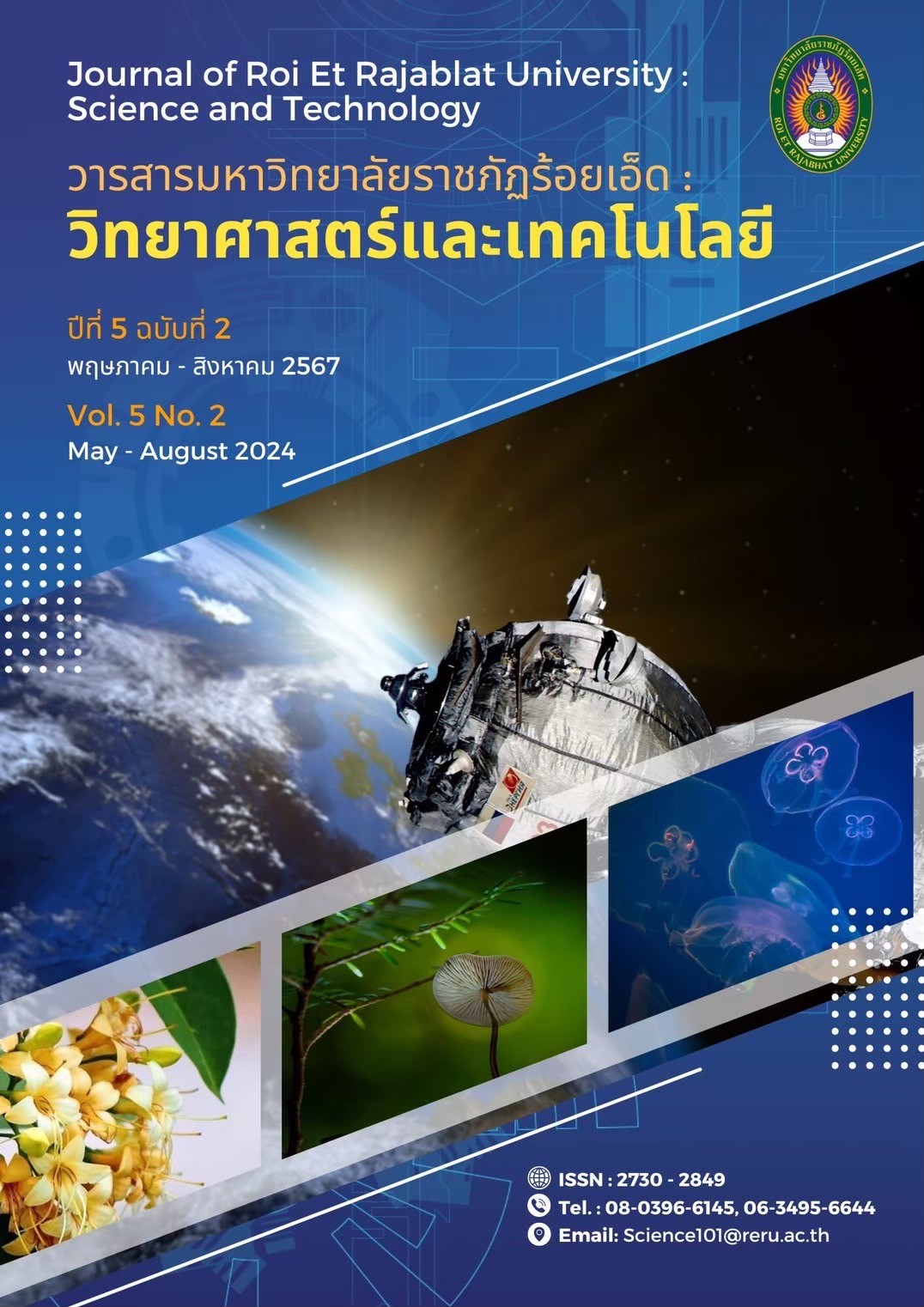การพัฒนาผลิตภัณฑ์เยลลี่กัมมี่จากสารสกัดใบชะมวง
คำสำคัญ:
ใบชะมวง, เยลลี่กัมมี่, ฤทธิ์ต้านอนุมูลอิสระ, คุณค่าทางโภชนการบทคัดย่อ
งานวิจัยนี้มีวัตถุประสงค์ในการพัฒนาผลิตภัณฑ์เยลลี่กัมมี่จากสารสกัดใบชะมวง โดยศึกษาปริมาณเจลาตินที่เหมาะสม (6, 8 และ 10 กรัม) และปริมาณความเข้มข้นของสารสกัดใบชะมวง
ที่เหมาะสม (5, 10 และ 15 เปอร์เซ็นต์ w/v) ผลการศึกษาผลิตภัณฑ์เยลลี่กัมมี่จากสารสกัดใบชะมวง ปริมาณ 100 กรัม พบว่าส่วนผสมที่ได้รับการยอมรับทางประสาทสัมผัสจากกลุ่มตัวอย่างมากที่สุดประกอบด้วย เจลาติน 8 กรัม น้ำอุ่น 18 มิลลิลิตร กลูโคสไซรัป 32.5 มิลลิลิตร น้ำตาล 33 กรัม
กรดซิตริก 2 กรัม และสารสกัดใบชะมวงความเข้มข้น 15 เปอร์เซ็นต์ w/v ปริมาณ 6.5 มิลลิลิตร โดยผลิตภัณฑ์มีค่าน้ำอิสระ ค่าสี ค่าความเป็นกรดด่าง ค่าปริมาณของแข็งที่ละลายได้ทั้งหมด ค่าเนื้อสัมผัส เป็นไปตามมาตรฐานประกาศกระทรวงสาธารณสุขฉบับที่ 213 พ.ศ. 2543 มีคุณค่าทางโภชนการให้พลังงาน 310.1 กิโลแคลอรี่ และสารสกัดใบชะมวงในผลิตภัณฑ์มีฤทธิ์ต้านอนุมูลอิสระ DPPH 47.23+0.20 มิลลิกรัมโทรลอกซ์ต่อ 100 กรัม ดังนั้นการเติมสารสกัดใบชะมวงจึงเป็นการเพิ่มมูลค่าให้ผลิตภัณฑ์เนื่องจากมีฤทธิ์ต้านอนุมูลอิสระที่เป็นประโยชน์ต่อสุขภาพของผู้บริโภค อีกทั้งเป็นการส่งเสริมให้มีการใช้สมุนไพรพื้นบ้านมากขึ้น นอกจากนี้ผลิตภัณฑ์เยลลี่กัมมี่จากสารสกัดใบชะมวงยังให้คุณค่าทางโภชนการสูง และได้รับการยอมรับจากผู้บริโภคจึงสามารถนำไปพัฒนาผลิตภัณฑ์เพื่อจำหน่ายในเชิงพานิชย์ได้ในอนาคต
เอกสารอ้างอิง
Boonyaprapat, N., & Chokchaicharoenporn, O. (1996). Medicinal plants indigenous to Thailand (2nded). Prachachon printing.
Keawsa-ard, S., Chuanphongpanic, S., & Dadcale, A. (2020). Development of Gummy Jelly from Measua ferrea Linn. Flower Extract. Thai Science and Technology Journal, 28(2), 2185-2200. https://li01.tci-thaijo.org/index.php/tstj/article/view/204425/170114
Meesang, S., Wuttijumnong, P., Pongsawatmanit, R., & Chenputhi, S. (2003). Effect of gelatin sucrose/glucose syrup ratio and citric acid on physical properties and sensory quality of gummy jelly product. Proceedings of 41st Kasetsart University Annual Conference, 3-7 February, 2003 Subject Agro Industry. (pp. 20-27). https://eurekamag.com/research/003/728/003728871.php
Nutrition Division Department of Health Ministry of Public Health. (2003). Recommended Daily Dietary Allowances for Healthy Thais (RDA) (3rd ed.) Printing Organization for the Delivery of good and Parcels.
Pattamadilok, C., Liangsakul, J., Sitthigool, S., & Suttisri, R. (2019). Chemical Constituents of Garcinia cowa Roxb. ex DC. and Their Cytotoxicity. CUAST Journal, 8(2), 99-108. https://www.council-uast.com/journal/upload/fullpaper/22-08-2019-198039034.pdf
Sakunpak, A., Matsunami, K., Otsuka, H., & Panichayupakaranant, P., (2017). Isolation of Chamuangone, a Cytotoxic Compound against Leishmania major and Cancer Cells from Garcinia cowa Leaves and its HPLC Quantitative Determination Method. Journal of Cancer Research, 6(2), 38-45.
https://doi.org/10.6000/1929-2279.2017.06.02.3
Sukkheng, S., Promdang, S., & Sawangmake, S. (2017). Indigenous vegetables with sour taste as valuable sources of bioactive compounds. Proceedings of 55th Kasetsart University Annual Conference: Plants, Animals, Veterinary Medicine, Fisheries, Agricultural Extension and Home Economics. (pp.288-295). https://kukrdb.lib.ku.ac.th/proceedings/index.php?/KUCON/search_detail/result/366497
Tangwattanachuleeporn, M., Piumkuntod, R., & Somoarn, P. (2008). Antimicrobial Acitivities of Garcinia cowa Roxb. Leaf Extract. The Public Health Journal of Burapha University, 3(2), 19-25. https://buuir.buu.ac.th/handle/1234567890/2889
Thongchin, T., Shuayprom, A., Ruengkhet, S., & Ontong, S. (2022). The Evaluation of Physico-Chemical Properties of Garcinia cowa Roxb. Leaves. Journal of Thai Traditional & Alternative Medicine, 20(3), 535-550. https://he01.tci-thaijo.org/index.php/JTTAM/article/view/254253/175925
ดาวน์โหลด
เผยแพร่แล้ว
เวอร์ชัน
- 24-02-2025 (2)
- 10-07-2024 (1)
รูปแบบการอ้างอิง
ฉบับ
ประเภทบทความ
สัญญาอนุญาต
ลิขสิทธิ์ (c) 2024 คณะศิลปศาสตร์และวิทยาศาสตร์ มหาวิทยาลัยราชภัฏร้อยเอ็ด

อนุญาตภายใต้เงื่อนไข Creative Commons Attribution-NonCommercial-NoDerivatives 4.0 International License.
บทความที่ได้รับการตีพิมพ์เป็นลิขสิทธิ์ของคณะศิลปศาสตร์และวิทยาศาสตร์ มหาวิทยาลัยราชภัฏร้อยเอ็ด
ข้อความที่ปรากฏในบทความแต่ละเรื่องในวารสารวิชาการเล่มนี้เป็นความคิดเห็นส่วนตัวของผู้เขียนแต่ละท่านไม่เกี่ยวข้องกับมหาวิทยาลัยราชภัฎร้อยเอ็ด และคณาจารย์ท่านอื่นๆในมหาวิทยาลัยฯ แต่อย่างใด ความรับผิดชอบองค์ประกอบทั้งหมดของบทความแต่ละเรื่องเป็นของผู้เขียนแต่ละท่าน หากมีความผิดพลาดใดๆ ผู้เขียนแต่ละท่านจะรับผิดชอบบทความของตนเองแต่ผู้เดียว






